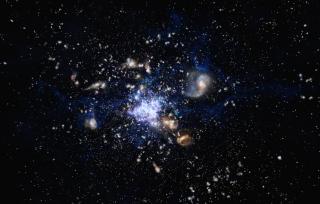Liu, Daizhong; Daddi, Emanuele; Schinnerer, Eva; Saito, Toshiki; Leroy, Adam; Silverman, John D.; Valentino, Francesco; Magdis, Georgios E.; Gao, Yu; Jin, Shuowen; Puglisi, Annagrazia; Groves, Brent
Referencia bibliográfica
The Astrophysical Journal
Fecha de publicación:
3
2021
Revista
Número de citas
50
Número de citas referidas
42
Descripción
We study the carbon monoxide (CO) excitation, mean molecular gas density, and interstellar radiation field (ISRF) intensity in a comprehensive sample of 76 galaxies from local to high redshift (z ∼ 0-6), selected based on detections of their CO transitions J = 2 → 1 and 5 → 4 and their optical/infrared/(sub)millimeter spectral energy distributions (SEDs). We confirm the existence of a tight correlation between CO excitation as traced by the CO (5-4)/(2-1) line ratio R52 and the mean ISRF intensity $\left\langle U\right\rangle $ as derived from infrared SED fitting using dust SED templates. By modeling the molecular gas density probability distribution function (PDF) in galaxies and predicting CO line ratios with large velocity gradient radiative transfer calculations, we present a framework linking global CO line ratios to the mean molecular hydrogen gas density $\left\langle {n}_{{{\rm{H}}}_{2}}\right\rangle $ and kinetic temperature Tkin. Mapping in this way observed R52 ratios to $\left\langle {n}_{{{\rm{H}}}_{2}}\right\rangle $ and Tkin probability distributions, we obtain positive $\left\langle U\right\rangle $ - $\left\langle {n}_{{{\rm{H}}}_{2}}\right\rangle $ and $\left\langle U\right\rangle $ -Tkin correlations, which imply a scenario in which the ISRF in galaxies is mainly regulated by Tkin and (nonlinearly) by $\left\langle {n}_{{{\rm{H}}}_{2}}\right\rangle $ . A small fraction of starburst galaxies showing enhanced $\left\langle {n}_{{{\rm{H}}}_{2}}\right\rangle $ could be due to merger-driven compaction. Our work demonstrates that ISRF and CO excitation are tightly coupled and that density-PDF modeling is a promising tool for probing detailed ISM properties inside galaxies.
Proyectos relacionados

Gas Molecular y Polvo en Galacias através del Tiempo Cósmico
Dos cuestiones fundamentales en la Astrofísica son la conversión de gas molecuar en estrellas y cómo este proceso físico depende del entorno en todas las escalas, desde sistemas planetarios, cúmulos estelares, galaxias hasta cúmulos de galaxias. El objectivo principal de este proyecto es el de estudiar la formación y evolución de galaxias a partir
Helmut
Dannerbauer